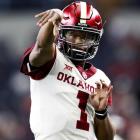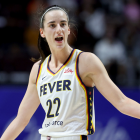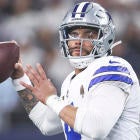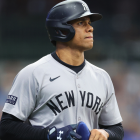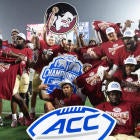There are a lot of things I love doing as a draft analyst, but probably my favorite "hobby" among them is comparing NFL draft prospects to players already in the pros. Some people hate making such comparisons, but I believe they provide perspective into the type of player a team will be getting in the draft.
It is, however, important to remember a couple things: NFL comparisons don't act as a guarantee a prospect will have the identical career to that of his pro counterpart, and comparisons for draftees don't factor into team situation or fit.
In this series, starting today with quarterback, I'll run through top prospects at every position and give my NFL comparisons -- some current players, some former. In some instances, a prospect will be compared to two pros as a way to represent a "range" or a ceiling and a floor for that prospect. Oh, and these comparisons are not based on size nor race.
They're almost solely stylistic.
(Prospects are listed in the order they appear in my draft rankings.)
Drew Lock, Missouri
NFL comparison: Matthew Stafford
Lock is a cannon-armed pocket passer capable of making the jaw-dropping throws down or across the field who plays the game with "shooter's amnesia." If he makes a bad decision or throws a pick, it doesn't impact his aggressiveness on the next play or series. He can effortlessly throw from a variety of arm angles, and the arrow is pointing up in terms of his pocket patience and presence, although hiccups in those areas are still present. He won't run away from many NFL linebackers but can pick up yards with his feet when needed, and his accuracy downfield is more impressive than his touch on short passes. Sounds a lot like Stafford.
As for the actual draft, you'll be able to stream our live coverage right here on CBS Sports HQ (or download the CBS Sports app for free on any mobile or connected TV device) breaking down all the picks and everything you need to know during draft weekend.
Kyler Murray, Oklahoma
NFL comparison: Steve Young
Hear me out on this one. Young was an ultra-efficient, frightening dual-threat quarterback at the collegiate level who could win from inside the pocket and could erupt with his legs thanks to high-level athleticism. That is Murray to a T. Young wasn't the biggest quarterback either at around 6-foot-0 and 210-ish pounds. It wasn't until Young landed with the 49ers that he reached his full potential -- and became a Hall of Fame signal-caller. He sat behind Joe Montana for his first four seasons in San Francisco and didn't become the starter until his age 30 (!) season. Murray's going to be starting for whichever team drafts him just a little earlier than that. Anyway, I'll admit I wasn't scouting Young when he came out of BYU after the 1983 season. In fact, I wasn't alive yet. But I do remember the way he could take over a game with pinpoint accuracy or as a scrambler in the NFL. Murray only showed it for one year in college, but I truly believe he has "take over the game" type skills as a refined passer and runner. Young was pretty unique. So is Murray.
Dwayne Haskins, Ohio State
NFL comparison: Drew Bledsoe
When I think of "pure" pocket passers -- and in this case that comes with a touch of a negative connotation denoting a serious lack of mobility -- Drew Bledsoe is one of the first quarterbacks who comes to my mind. Bledsoe was statuesque in the pocket; he just wanted to live there and fire rockets all over the field. Yes, there was an occasional step up away from pressure, but most often Bledsoe either delivered the football from inside the pocket or was hit or sacked inside the pocket. I see a lot of that with Haskins, a slow-footed, pure pocket passer. He's a little more athletic than Bledsoe was, but Bledsoe had a stronger arm. I wasn't scouting Bledsoe when he was a prospect in 1993. I was scouting bad guys Power Rangers had to fight. But I do have vivid memories of Bledsoe in the NFL. Haskins can read the entire field, is mostly accurate, and wants to set up shop between the tackles on every snap. If protected well, he can be an awesome quarterback in the NFL. Like with Bledsoe, I'm worried about Haskins when he faces pressure.
Ryan Finley, NC State
NFL comparison: Ryan Tannehill
Finley and Tannehill are stylistically so similar it's scary. From their throwing motions to their strengths and weaknesses, Finley is a Tannehill clone. At NC State, Finley had elite-level outings in which he made a handful of high-degree-of-difficulty tosses that needed plenty of anticipation and accuracy. He also had his fair share of stinkers, games in which he looked completely out of sorts against blitzes and/or complex coverages and his lack of arm strength was very apparent. Both Finley and Tannehill are quietly effective as scramblers too.
Brett Rypien, Boise State
NFL comparison: Marc Bulger
Another throwback, and it seems perfect. Bulger was an intelligent quarterback who had a brief stint as one of the most efficient passers in the league who got it done with his mental processing, accuracy, and quick release from inside the pocket without having standard NFL size, athleticism, or arm strength. While watching Rypien's illustrious career unfold at Boise State, I got that same vibe. Rypien actually takes hits and sacks at times because he doesn't notice pressure. He almost always keeps his eyes up to scan the field. Love that attribute; many passers have a tendency to drop their eyes when they initially don't like what they see or feel pressure. Rypien has a decent, not great arm, consistently throws with anticipation, and you don't have to worry about him misfiring to any portion of the field.
Will Grier, West Virginia
NFL comparison: Andy Dalton
Dalton was a second-round pick out of TCU in 2011, and his effectiveness in the NFL has largely been contingent upon the talent around him: Offensive line and receivers. Grier seems like that type too. When kept clean, Dalton, who isn't big for the position and doesn't have a huge arm, can make any throw. Under pressure he typically crumbles ... another way Grier is just like him. At West Virginia, when he was out of harm's way, Grier was accurate and knew where to throw the football. Under pressure ... not so much. If he lands with a team that has an impressive collection of receivers and a good line, Grier can be a mid-level quarterback in the NFL, capable of high flashes. If that's not the situation in which he lands, Grier's likely to struggle.
Daniel Jones, Duke
NFL comparison: Josh McCown
I don't know if Jones will ultimately stick around for as long as McCown has, but they seem like similar quarterbacks. Smart, good arm, decently accurate to all levels but antsy under pressure and can be somewhat easily baited into making bad decisions. Jones is a plus scrambler, yet the team that drafts him likely won't be installing designed runs for him, although he was used on those at Duke. Anyway, Jones is a West Coast Offense signal-caller who you don't want holding onto the ball for too long.
Tyree Jackson, Buffalo
NFL comparison: Colin Kaepernick
Jackson measured in as the biggest quarterback in combine history and had one of the most athletic showings ever at that position. Kaepernick was no slouch athletically either, and while he's not quite as big as Jackson, he was listed just under 6-5 and 233 pounds as he entered the league in 2011. In college, Kap repeatedly threw fastballs all over the field. That's Jackson too. Kap was probably a little more accurate on short passes than Jackson, but the Buffalo product is more competent stretching defenses deep. Kaepernick was "projecty" and so is Jackson. Like Kap, in the NFL Jackson will need to get faster going through his reads and calmer staying inside the pocket.












